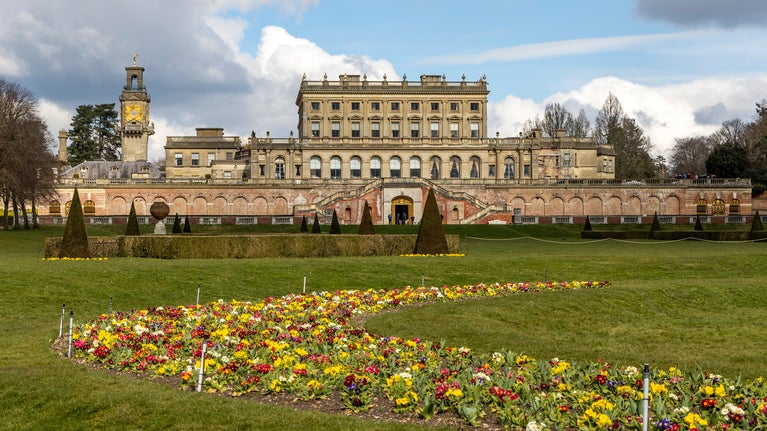
Discover more at Cliveden
Find out when Cliveden is open, how to get here, the things to see and do and more.

Follow in the footsteps of dukes, earls, kings and queens as you stroll through a series of impressive spaces at Cliveden, each with its own special charm. Enjoy year-round interest and colour, from the bedding scheme of the Parterre and the hundreds of roses in the Rose Garden, to Lord Astor’s sculpture collection and the impressive Cliveden Maze.
Head to Cliveden this spring and discover the daffodils in and around the estate from the middle of February through to April. Click the link below to find out more about Daffodils at Cliveden.

At this time of year, areas of our ancient woodland come alive with a gorgeous deep blue hue. Bluebells are an essential part of our natural heritage, and a welcoming sign that spring is well under way. Click the link below to find out more about the Bluebells Walk.
Spring is the time to enjoy the winter/spring bedding display at Cliveden. Each autumn we plant thousands of bedding plants (polyanthus this year) and spring bulbs (hyacinths and multiple varieties of tulip) that come into flower throughout the spring season. The best areas to enjoy this riot of dazzling colour are the Parterre, the Duke's Garden, the Semi-Circle and the Lower Terrace.
Lots of other areas around the Cliveden estate come to life in early spring but the Water Garden in particular provides our visitors with great colour and interest. In March, as you walk on the main circular path from the maze you will pass a group of delightful little iris that have real staying power throughout the season. Iris unguicularis, the Algerian iris, has flowers that are beautifully decorated with white and orange markings and it can flower all the way through from the start of the new year through to late April.
Another plant in the Water Garden is highly prized for its intoxicating fragrance in spring. Azara microphylla is a small tree with glossy, obovate leaves that resemble box (buxus) leaves. The tiny yellow flowers on this tree are massed along the branches and fill the air with the scent of vanilla.
The plant that probably draws most attention in the Water Garden in the spring is the stunningly fragrant Daphne bholua 'Jacqueline Postill'. Flowering for a long period, from winter into the early part of spring, daphnes make a wonderful addition to any garden and there are several to choose from that are nearly all very sweetly scented.
Restoration work on the Long Garden begins and will continue through to Spring 2025. During this period, there may be limited access to some parts of the Long Garden but visitors will still have the opportunity to observe the conservation work in progress.
The project will involve significant updates, including replacing the central path with durable York stone paving, removing the old box hedging in favour of more resilient Yew hedging, replanting four central beds, and installing new, automated gates at the entrance.
Our aim for this restoration is to create a more sustainable planting scheme that pays homage to Norah Lindsay’s original early 20th-century designs. Situated along the north boundary of the estate, parallel with Bourne End Road, the Long Garden will be updated to reflect both its historic roots and modern ecological considerations.
We have taken the opportunity to do something unique this summer at Cliveden that references a time when the Long Garden was used to grow fruit and vegetables and will also be learning some valuable lessons for when we return Cliveden’s Walled Garden to being a productive area in the coming years. Find out more about the project by clicking the link below.

In 2024, the garden team changed the bedding by taking more than 12,000 wallflowers, tulips and hyacinths from the Parterre, and replaced these with a striking combination of red and white begonias, interlaced with ribbons of red salvias and white antirrhinums. With red and white geraniums in the Parterre’s yew obelisk beds, it promises to be a vivic display.
In the Parterre’s large semi-circle bed, we will be planting chlorophytum – the spider plant – as a border to a bold display of almost 6,000 red Beacon Impatiens (Busy Lizzies), and the bedding in the Duke’s Garden in 2024 will also be a must-see – around 2,000 Osteospermum Voltage Yellow dotted throughout with Canna Cannova Bronze Scarlet. It should be an electric combination.

The recent new planting schemes in the Water Garden are really starting to mature now, offering an array of both colour and scent from spring all the way through to the winter months. The Acers, Tai Haku (Great White Cherry) and a Wedding Cake Tree in our new project bed on the right hand side as one enters the Water Garden gave beautiful blossom in the spring. King George rhododendrons, one of the best hybrid rhododendrons with soft pink flower buds that open to pure white and give off a lovely fragrance, are planted at either end of the same bed and provide a wonderful sight. Along the back of the bed are spreading hydrangeas with lilac blue flowers to provide a beautiful backdrop.
Elsewhere in the Water Garden, the pond renovation scheme completed in Summer 2024. The ponds were built in the late 1890's and the concrete that lined them was cracking, allowing water to escape. Now that the repairs have been completed, we will be saving gallons of water every year.
The carp are very happy to be back in their new home and we look forward to seeing how our new aquatic planting scheme of waterlilies, marsh marigolds, iris and myosotis establishes over the coming years’. The Water Garden may take some time to settle after the disruption, but the de-silted, cleaner ponds means that the waterlilies and fish will have more space to thrive.
Situated in front of the house are two large, double-width herbaceous borders that provide a dazzling display of colour in the summer months. Based upon designs made in the 1960s by Graham Stuart Thomas, the noted horticulturalist and former Gardens Consultant to the National Trust, these visitor favourites feature one hot border filled with tones of red, yellow and orange while the cool border (running alongside the Clock Tower lawn) contains tones of blue, white and purple. The displays are so full that you can spot something new each time you visit, with dahlias, thalictrum, salvias, penstemons and asters drawing particular attention at the height of the season.
Cliveden’s Rose Garden – originally designed by Sir Geoffrey Jellicoe for the 3rd Lord Astor in the 1950s – is a unique take on an ‘Edwardian style’ rose garden. With around 850 roses – including shrubs, floribunda, hybrid teas and climbers – the garden provides a wonderful array of colour from June all the way through to the autumn months.
In 2024, will see the first flowering of the 70 new rose plants that we planted in November 2023, when we excavated and replaced over 20 tonnes of soil. Jellicoe’s scheme has a dramatic colour combination, sweeping from yellow in the east through amber and orange to red in the west and we think the five new varieties that we have introduced – Sir John Betjeman, Sophy’s Rose, Dannahue, Bring Me Sunshine and Roald Dahl – will make a bold addition to the garden’s established design.
At the same time, we have this year introduced a selective range of underplanting in some of the rose beds. With alliums, comfrey, nepeta and Lady’s Mantle, we will be extending the season of interest and – we hope – improving soil health and attracting a more diverse range of pollinators as well.
Did you know the main visitor car park was originally a walled garden created to supply the estate with fruit and vegetables? We've been working to reinstate the kitchen garden’s character by planting fruit trees against the walls.
From spring to autumn the Walled Garden provides produce for the estate to use, from lettuce to plums. There is a walk around the perimeter of the main car park for you to get up close to see what we’re growing.
Cliveden provided the Canadian Red Cross with a hospital during the First World War. In 1918, the 1st Viscount Astor's sunken Italian garden was adapted to create a memorial garden for the deceased. It contains 42 war graves from the First World War, each marked with a stone set in the turf.
If you are planning to make a special trip solely to visit the war graves, please email or call us in advance on 01628 605069. If you would like to incorporate a visit to the War Memorial Garden while exploring the wider estate, please note usual admission charges apply.
The apple trees trained around the arched structures of the Round Garden are heavy with fruit in the autumn. It's worth a wander through the apple 'tunnels'. The restoration of the garden at Cliveden has revealed many secrets, including a long-lost fruit garden on the northern edge of the woodlands, just a short walk from Green Drive. The Round Garden was laid out in the mid-19th century and is possibly the only surviving example in the UK of a circular fruit orchard from this period.
Having been out of production since the 1950s, it has been brought back to life by the ranger team who are protecting heritage trees and planting many new ones. Wildlife flourished while it was out of action, making it a haven for rare insects and fungi, as well as bats and birds.
We'd love for you to cycle to Cliveden and you can lock bikes up in the spaces provided in the Walled Garden. 5 year olds and under are able to bring small scooters and balance bikes onto the estate. Mobility scooters can also be taken onto the estate but please leave bikes with pedals by the Information Centre.

Find out when Cliveden is open, how to get here, the things to see and do and more.

Cliveden has many sculptures in its grounds, including ancient baboons and bold choices of ‘new art’ sculpture from Cliveden’s 19th-century owners.

Discover majestic trees, tranquil glades and far-reaching views as well as some unusual features in Cliveden’s woodlands, including a flint grotto and part of a giant sequoia tree.
Restoration work on the Long Garden begins and will continue through to Spring 2025. During this period, there may be limited access to some parts of the Long Garden, but visitors will still have the opportunity to observe the conservation work in progress. The project will involve significant updates, including replacing the central path with durable York stone paving, removing the old box hedging in favour of more resilient Yew hedging, replanting four central beds, and installing new, automated gates at the entrance. Our aim for this restoration is to create a more sustainable planting scheme that pays homage to Norah Lindsay’s original early 20th-century designs. Situated along the north boundary of the estate, parallel with Bourne End Road, the Long Garden will be updated to reflect both its historic roots and modern ecological considerations.

Cliveden is a two pawprint rated place. Dogs are welcome across many areas, with woodlands, riverbank and a formal garden all offering a variety of dog-friendly walks.

From fun walking trails to boating on the Thames this spring, this is your one-stop shop to help you get the most out of your family visit to Cliveden.

From 18th-century water gardens and Arts and Crafts landscapes to intimate woodland gardens, there are so many places to discover.

Discover our gardeners’ top tips so you can make the most of your garden, plot or window box.

Gardens from the grand scale of Stowe's landscape garden to formal parterres at Hughenden and Cliveden and the intimate walled garden 'rooms' at Greys Court.